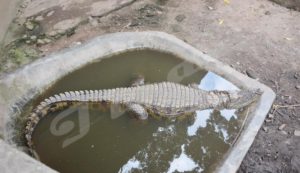Created to be an excellent display of the artistic, cultural and animal beauty of Burundi in the capital, “Musée Vivant”, a tourist site, is in danger of disappearing if nothing is done.

A crocodile inside “Musée Vivant’’
At the entrance of this tourist site almost in the heart of the capital, craftsmen of all kinds are seen in the western part of the museum. There are magnificent hand-made traditional objects for decoration, earrings, bracelets…. displayed at the entrance of each shop.
Craftsmen met on the spot say the number of customers has considerably decreased since 2015. “The number of customers has considerably gone low due to the crisis that broke out in 2015 and greatly affected the city. Since then, we receive a small number of visitors,” he says adding that there is a small improvement compared to 2015.
This place also offers visitors an opportunity to discover traditional houses and some specimens of animals found in the waters and forests of the country. “There are six crocodiles, a leopard, two chimpanzees, an antelope, snakes of different species and small fishes in an aquarium”.
The guide says the number of animals present on the site has reduced over the years. “When an animal dies, it is difficult to replace it. This is the reason why the species have reduced,” he says, showing a turtle shell “You can see the turtle has recently died but it has not yet been replaced”.
The economic and political crisis that broke out in the country in 2015 has not spared this museum. “Today, we can receive an average of ten people per day. The number has gone low since 2015,” says the guide. The absence of tourists in the museum affects its proper functioning.
Despite the effects of the crisis, “Musée Vivant” is still attractive to some young people who enjoy sitting on the crocodile, holding snakes, listening to the guides’ information about animals, traditional objects and huts inside the museum.
“I didn’t know there are all those species of snakes. I enjoyed playing with chimpanzees and discovering traditional objects,” says Emery, a young man from Kanyosha, a southern neighborhood in Bujumbura city.
Arlène, a young woman who has come to visit the museum is also impressed. “The zoo is always amazing because of its beauty and diversity. The warm welcome and the deep explanations of the guides are important because we learn a lot of things”.
She however calls on the government to put much effort in the preservation of this traditional wealth. “I visit this place at least once a year and I can see that there are species that are disappearing. You can see the empty places where crocodiles, turtles, lizards…, used to live,” she says.
The World Tourism Day, which is celebrated every 27 September is a unique opportunity to raise people’s awareness of the tourism’s actual and potential contribution to sustainable development.



















 IWACU Open Data
IWACU Open Data

